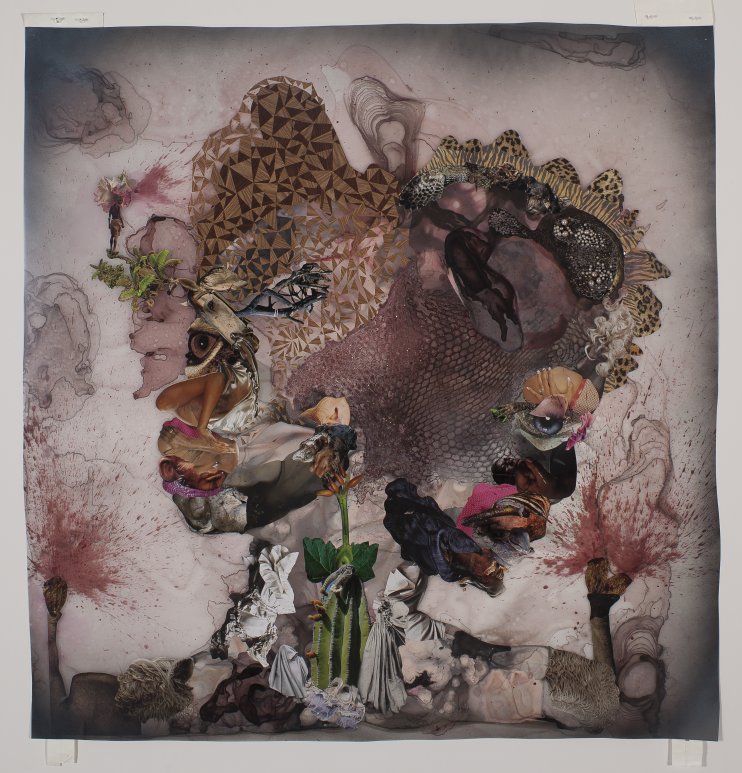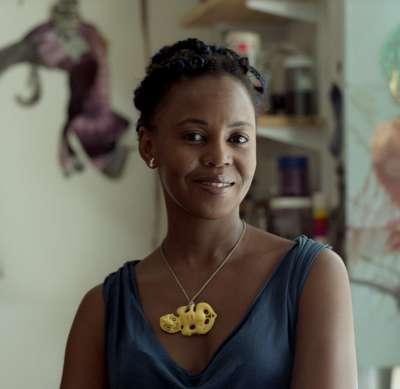Artist Wangechi Mutu will give a talk on her work and life on Tuesday, February 15, 2011, from 1 to 2 pm, in the Katie Murphy Amphitheatre. The Amphitheatre is located in the Fred P. Pomerantz Art and Design Center (also known as the “D” Building), 27th Street and 7th Avenue, at the Fashion Institute of Technology.
Kenya-born Wanechi Mutu creates compelling and intricate artworks containing painted and collaged images, often using female figures constructed with photographic fragments of idealized women collected from print magazines. Her visually complex work can also be seen as a critique of the portrayal of black women as either tribal aborigines or hypersexualized pinups.
Mutu’s artwork has been exhibited extensively in the U.S. and abroad. Her most recent solo shows include Hunt Bury Flee at the Gladstone Gallery in Chelsea, New York City, My Dirty Little Heaven at the Deutsche Guggenheim, Berlin, Germany, and the Wiels Contemporary Museum, Brussels, Belgium, and This You Call Civilization? at the Art Gallery of Ontario, Toronto, Canada. She has won numerous awards including the Deutsche Guggenheim Artist of the Year for 2010, a Louis Comfort Tiffany Foundation Grant, and a Cooper Union Urban Visionaries Emerging Talent Award.
You can watch the video of Wangechi Mutu’s lecture at FIT here:
You can find out more about Wangechi’s artwork by going to her website: http://www.wangechimutu.com/



2/17/11
I appreciated the presentation given by Wangechi Mutu. She is not someone that I was at all familiar with. Seeing her work for the first time was absolutely amazing. Her art work completely blew me away. You have no idea how inspiring this artist has been for me. It is so hard to find African or African American women in the art world who are positive role models. Wangechi carried with her a wealth of knowledge and understanding of her cultural background that many people would take for granted. It was more than the archive of information that I found intriguing. It was the eloquence with which she spoke that made her presentation that much more captivating. That is why I am compelled to say that in my opinion she is a woman of great distinction.
I want the school to realize and understand how important it is that the students at FIT be exposed to speaker from every walk of life of this caliber. We are a multicultural school, so why wouldn’t we have a multicultural speakers showcase? This will help to better inform and expose the students to a plethora of ideas, possibilities, and give them the direction they need to follow their artistic desires. Please take what I have said into consideration. FIT only stands to benefit from this so consider it as a gain and not a loss of revenue because an investment in your students is an investment in our school.
Sincerely,
Erica L. Geralds
Wangechi Mutu’s general theme of combining the familiar aspects of tragic and grotesque historical images and events, with the familiar aspects of Western and African socialized femininity, fashion and sexual beauty totally related to me. As a young woman born and raised in New York City, I am confronted with overt sexuality everywhere I go. It’s in advertising plastered on the city streets, underground in the subways, magazines in store fronts, clothing store windows, it’s everywhere. I feel an inner struggle between my Persian background, and the edgy New Yorker within me at times.
Seeing how Wangechi Mutu combined the polar opposite facets of her own culture in her captivating, attention arresting collages and watercolor pieces showed me how connected everything is when it is expressed from the same source. This inspired me to incorporate details of where I come from in the biological sense with the aspects of where I was born and raised. Both of those things make us who we are, and that in itself makes them connected.
I found the inspiration for her art to be really fascinating, very morbid but fascinating. You could tell her background really had a voice in her work too.
I found Wangechi Mutu’s lecture to be very interesting. What I appreciate most about her work is its elegance. She comes from such a dark aspect of world history that one might expect her work to be brash, full of gore and anger. However, instead she handles such powerful topics such as race, colonization, and mutilation all with a very graceful touch. In my opinion, her outlook toward these issues is shaped heavily by her idols. With admiring such strong female figures as Nina Simone and Eartha Kitt her approach to difficulties are met like those icons with quiet tenacity.
That juxtaposition between power and the powerless, beauty and horror led me as the viewer to feel extremely uncomfortable which I think she absolutely intended. I feel compelled to call them beautiful but that does not explain them completely. When speaking of their beauty one must also include their raw grotesqueness also.
I hope to see her work in person one day. From what I can tell, there are a lot of intricacies and smaller details that were a little bit hard to tell in the handouts and the slides. She is definitely one artist I am glad I was introduced to and one that I will keep on my radar.
Art expresses itself differently for each individual artist, the artist can draw on their culture, their past experiences or even just pure abstraction as their main focus. Wangechi Mutu is one such artist that draws on her culture as well as historical events as the main focus in her art. Mutu’s work is full of vigor and devotion, creating detail oriented paintings and drawings spilling with significance. Mutu looks at sickening events in Africa to build off of as well as having a strong interest in the distortion of the female form.
Color and collage is an element of Wangechi Mutu’s work that is of great importance. The color palette in which Wagechi Mutu uses is stark and sophisticated. Wide array of colors are used as well as a curious application of these colors to create a piece of artwork that shines with vibrancy. Mutu described in her lecture how she is constantly collecting magazine photographs in which she dilligiantly puts together to make an appealing whole. These collages she constructs relate to the distorted female form in many cases, as well as relating the female to an animalistic quality in nature. The collages are just a base for the works in which she creates.
Wangetchi Mutu’s breadth of work drew from magazines as a chief component. In Mutus Pin up series, Mutu created small works of art on paper with watercolors as her medium. Josefine Baker, a french dancer was the chief inspiration for Mutus pin up series, she looked to her for a sense of fiction and fakeness, in which she created her own fake and distorted figures. This fakeness seen in Josefine Baker might be related to the fakeness of the world, therefore making everyone a displaceable aspect of it. Mutu described Josefine baker as a “gorgeous buffoon” Being a gorgeous buffoon, Josefine Baker played on using quirky, silly movements on stage making her beauty mix with a sense of stupidity. In Mutus other series based on collage, she sought to connect the figure with a face. In this series of the correlation between figure and face , Mutu drew on masks for inspiration. Mutu created eye puzzling works that made it difficult to distinguish the figure and the mask and gave a feeling of depth to the artwork. The correlation and eye trickery made the pieces bring the foreground into the background while also bringing the background to the foreground.
Mutu Baker not only draws on the people of the time but also the events that transpired in Africa as well as her new home in New York. Mutu looked at the work of Hannah Hoch, an artist of the dada movement for inspiration. Hannah Hoch used collage as a means to politicize art and culture which Mutu also sought to do. Both Mutu and Hoch share an interest in creating a “shock” factor within their artwork. Mutu talks about the protest of a group of woman in kenya, whom took their clothing off in front of an Anglo-Belgian rubber India torture building. Kenya was and still is a very conservative and restricted area, where woman taking their clothing off was seen as very powerful and obscene. Mutu created a sculpture she titles“fat legs”, in the work fat legs Mutu drew on the comforting factor of the female form in a world of troubles. Mutu describes that when she moved to new york she felt hardship in adjusting, and felt like she was living in a city that constantly displaces you. Mutu used art as a therapeutic form, as an escape from a world that doesnt need you or forgets easily. In Mutus next series, she drew on the alienation of portraiture as the base or preliminary idea behind her work. Looking at mug shots she created this series that emphasized a sense of alienation. This series draws on the idea that we are all just subjects in this city and if we take a break the city still functions without us.
Art can be expressed through many different forms of expression. Wangetchi Mutu uses primarily collage to depict her feelings about society and the hardships that occur within it. Mutu also draws inspiration from all over, ranging from female performers to the history of her african culture. We artists should all learn from Wangetchi Mutu and dive into our own experiences that shape our artwork, from their we can grow as artists as well as individuals within an ever-changing society.
She is an amazing artist, but I am usually attracted to works that are less mainstream and leave much to the imagination. Where some may see something as grotesque or shock, I see beauty.
My Dirty Little Heaven sounds like a helluva show. I love her color palette and how her dark rich pieces still carry such a vibrancy.